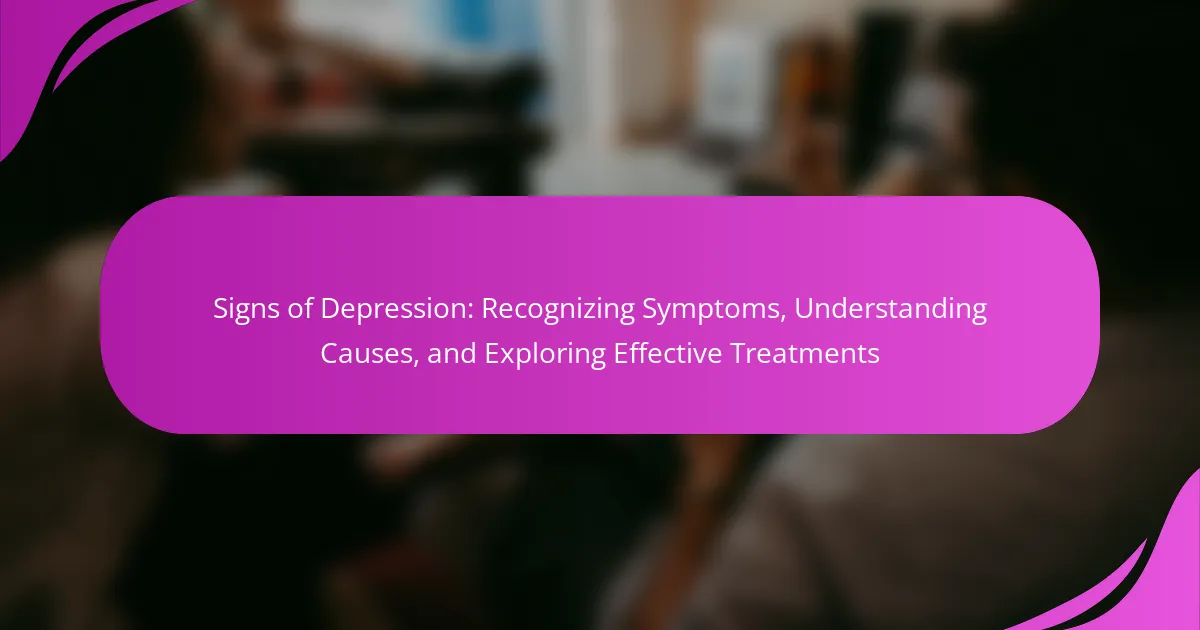Recognizing the symptoms of bipolar disorder is essential for effective management and treatment. Key indicators include mood swings, energy changes, and alterations in behavior. Individuals may experience manic episodes with heightened energy or depressive episodes marked by sadness. Treatment options encompass medication, therapy, and lifestyle adjustments to improve overall well-being.
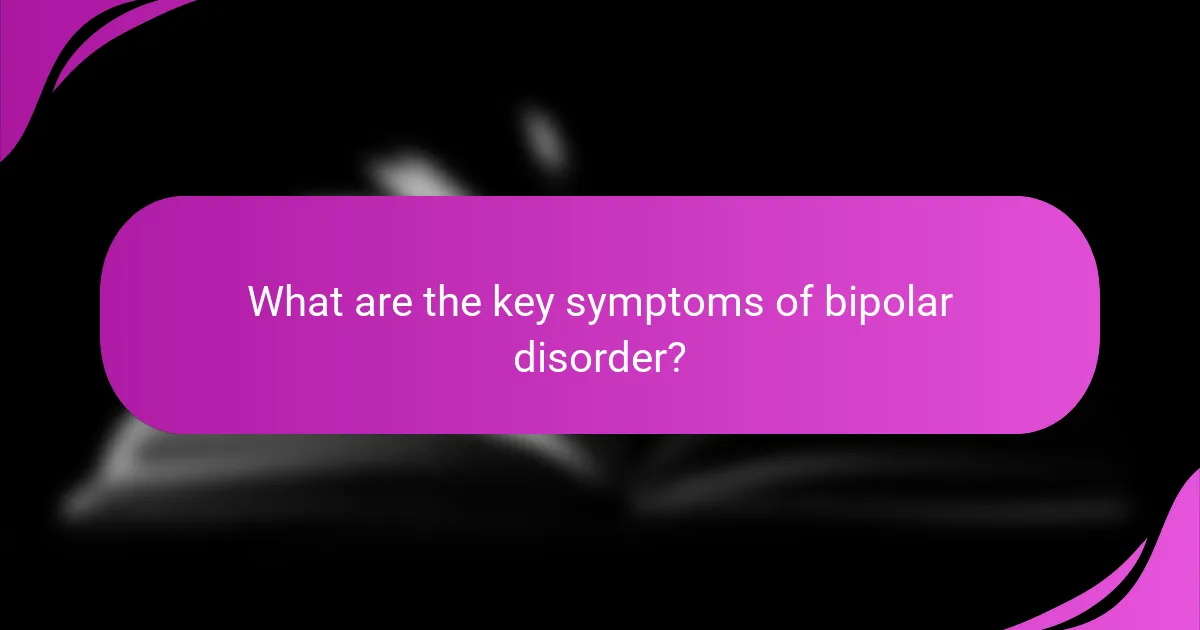
What are the key symptoms of bipolar disorder?
Bipolar disorder symptoms include extreme mood swings, energy fluctuations, and changes in behavior. These symptoms can manifest as manic episodes, characterized by elevated mood and increased activity, or depressive episodes, marked by sadness and lethargy. Recognizing these patterns is crucial for effective treatment. Early intervention can significantly improve outcomes for individuals experiencing bipolar disorder.
How do mood swings manifest in individuals with bipolar disorder?
Mood swings in individuals with bipolar disorder typically manifest as extreme emotional fluctuations. These can range from intense highs (mania or hypomania) to severe lows (depression). During manic phases, individuals may experience heightened energy, euphoria, and impulsive behavior. Conversely, depressive episodes can lead to feelings of sadness, fatigue, and hopelessness.
The duration of these mood swings can vary significantly, lasting from days to weeks. A unique attribute of bipolar disorder is the rapid cycling of moods, where individuals may experience multiple mood episodes within a single year. Treatment options often include mood stabilizers, psychotherapy, and lifestyle changes to manage these symptoms effectively.
What are the different types of mood episodes?
Bipolar disorder includes different types of mood episodes: manic, hypomanic, depressive, and mixed episodes. Manic episodes involve elevated mood, increased energy, and impulsive behavior. Hypomanic episodes are similar but less severe. Depressive episodes feature low mood, fatigue, and loss of interest. Mixed episodes combine symptoms of both mania and depression, leading to significant distress. Understanding these episodes is crucial for effective treatment and management.
How do mood swings affect daily functioning?
Mood swings significantly impair daily functioning by affecting emotional stability, decision-making, and interpersonal relationships. Individuals with bipolar disorder may experience extreme highs and lows, leading to inconsistent behavior. During manic phases, they may exhibit impulsive actions, while depressive episodes can cause withdrawal and lack of motivation. As a result, maintaining work, social interactions, and personal responsibilities becomes challenging. Effective treatment options, including therapy and medication, can help stabilize mood and improve overall functioning.
What energy changes are commonly experienced?
Bipolar disorder commonly causes significant energy changes, including periods of heightened energy known as mania and low energy during depressive episodes. These fluctuations can lead to impulsivity and fatigue, impacting daily functioning. During manic phases, individuals may experience increased productivity and restlessness, while depressive phases often result in lethargy and a lack of motivation. Recognizing these changes is crucial for effective management and treatment.
What is hypomania and how does it differ from mania?
Hypomania is a milder form of mania, characterized by elevated mood, increased energy, and reduced need for sleep. Unlike mania, hypomania does not cause significant impairment in social or occupational functioning. Symptoms include heightened creativity and productivity, but may lead to irritability or impulsivity if not managed. Treatment options for hypomania typically involve mood stabilizers and psychotherapy to help regulate mood swings and prevent escalation to full-blown mania.
What are the signs of depressive episodes?
Common signs of depressive episodes include persistent sadness, loss of interest, changes in sleep patterns, fatigue, and difficulty concentrating. These symptoms can significantly impact daily functioning. Recognizing these signs is crucial for seeking appropriate treatment options. Treatment may involve therapy, medication, or lifestyle changes, tailored to individual needs.
How can one recognize the patterns of mood changes?
Recognizing patterns of mood changes in bipolar disorder involves observing distinct shifts in mood, energy, and behavior. Key indicators include extreme highs (mania) and lows (depression), often occurring in cycles. Tracking these changes over time can reveal triggers and help manage symptoms effectively. Keeping a mood diary can aid in identifying these patterns, enhancing awareness of emotional states and their frequency. Regular consultations with a mental health professional can also provide insights and tailored treatment options.
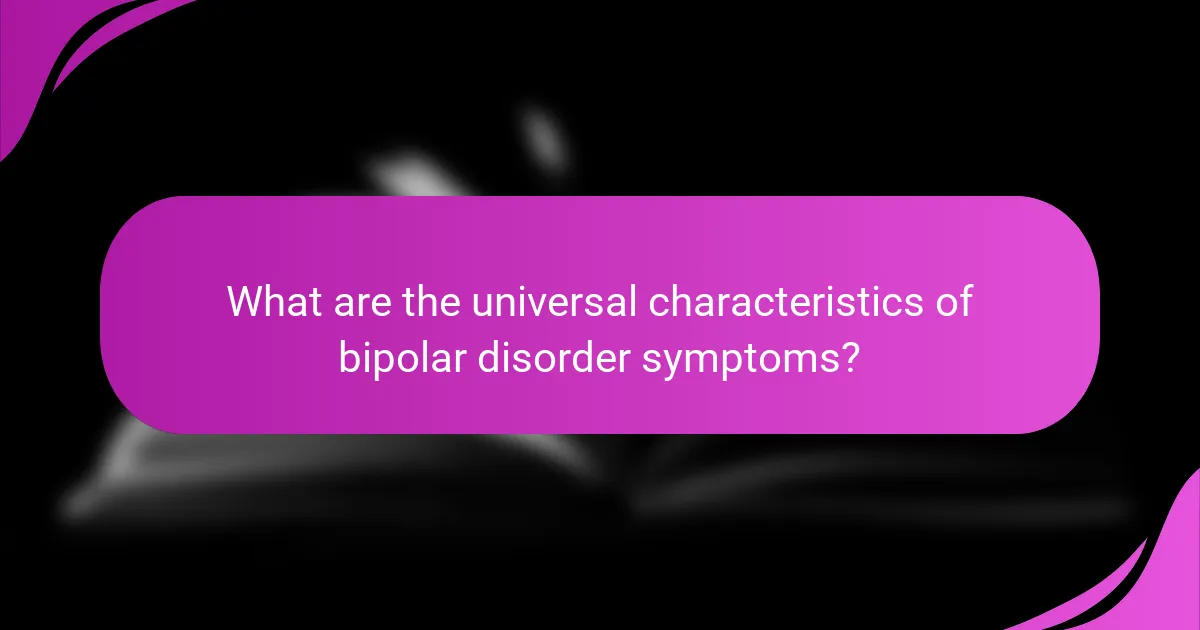
What are the universal characteristics of bipolar disorder symptoms?
Bipolar disorder symptoms universally include mood swings, energy level changes, and alterations in sleep patterns. Individuals may experience manic episodes characterized by heightened energy and euphoria, followed by depressive episodes marked by low energy and sadness. Recognizing these patterns is crucial for effective treatment. Treatment options typically involve medication, therapy, and lifestyle changes.
How do symptoms vary between different individuals?
Symptoms of bipolar disorder can differ significantly among individuals. Factors such as genetics, environment, and personal experiences contribute to this variability.
During manic episodes, some may experience heightened energy and euphoria, while others may feel irritable or agitated. In depressive phases, symptoms can range from profound sadness to feelings of emptiness or hopelessness.
Unique attributes of bipolar disorder include variations in the duration and intensity of mood swings. Some individuals may have rapid cycling, experiencing multiple episodes within a year, while others may have longer periods of stability.
Recognizing these differences is crucial for effective treatment. Tailored approaches can enhance management and improve overall well-being.
What role does family history play in symptom presentation?
Family history significantly influences the presentation of bipolar disorder symptoms. Genetic predisposition can lead to variations in mood swings and energy levels. Studies indicate that individuals with a family history of bipolar disorder are more likely to experience severe symptoms and rapid cycling. Understanding this connection can guide treatment approaches, emphasizing the need for personalized care. Identifying family patterns aids in early intervention and management strategies.
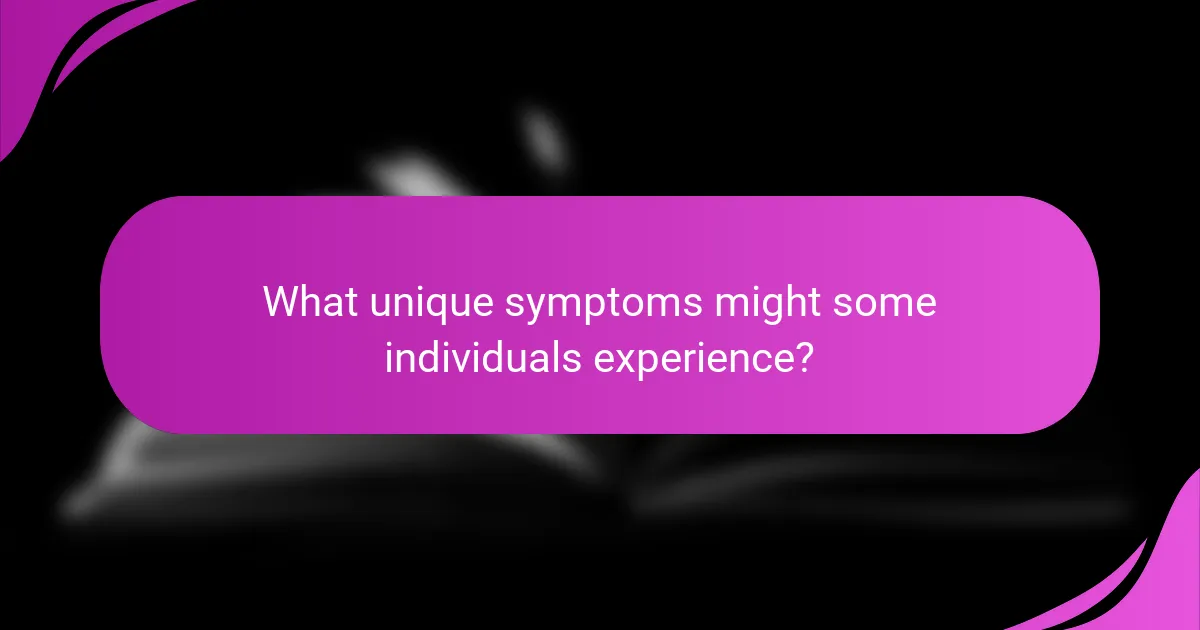
What unique symptoms might some individuals experience?
Some individuals with bipolar disorder may experience unique symptoms such as heightened creativity during manic phases, intense irritability, or sleep disturbances. These symptoms can vary significantly among individuals, highlighting the disorder’s complexity. Additionally, some may face rapid cycling, where mood changes occur frequently within a short period. Recognizing these unique symptoms is crucial for effective treatment and management strategies.
How do rapid cycling episodes affect symptom recognition?
Rapid cycling episodes complicate symptom recognition in bipolar disorder by causing frequent mood shifts. These shifts may lead to confusion in identifying baseline mood states, making it challenging to discern patterns. Individuals might misinterpret symptoms as normal fluctuations, delaying effective treatment. Rapid cycling can manifest in unique ways, such as increased irritability or impulsivity, which may differ from typical manic or depressive episodes. Recognizing these nuances is crucial for accurate diagnosis and timely intervention.
What are the signs of mixed episodes?
Signs of mixed episodes in bipolar disorder include simultaneous symptoms of mania and depression. Individuals may experience high energy levels alongside feelings of hopelessness. Common signs are irritability, anxiety, rapid mood swings, and difficulty concentrating. These episodes can lead to increased risk-taking behaviors and significant distress. Treatment options often involve mood stabilizers and psychotherapy tailored to manage these complex symptoms.
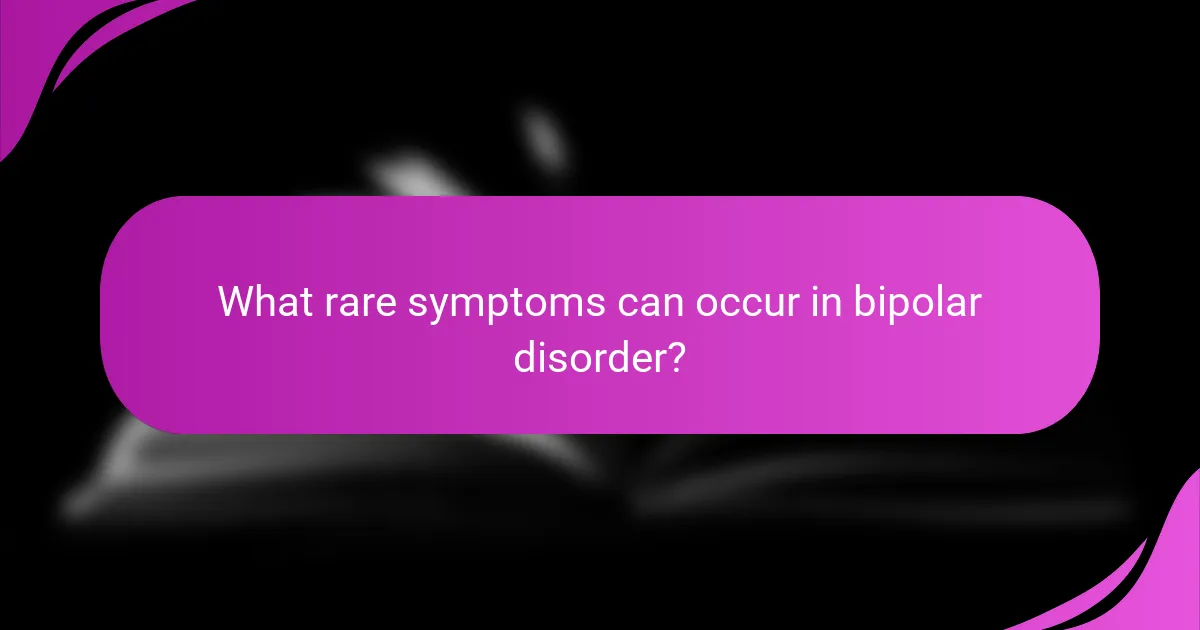
What rare symptoms can occur in bipolar disorder?
Rare symptoms of bipolar disorder can include psychosis, such as hallucinations or delusions, and catatonia, characterized by unresponsiveness or abnormal movements. These symptoms, while not common, can significantly impact a person’s experience with the disorder. Other rare manifestations may involve intense paranoia or rapid cycling between mania and depression. Recognizing these unusual symptoms can be crucial for effective treatment and support.
How can psychotic features complicate symptom recognition?
Psychotic features can obscure the recognition of bipolar disorder symptoms by introducing delusions or hallucinations. These symptoms may mask mood swings, making it difficult to identify shifts in energy levels. As a result, individuals might misinterpret their experiences, complicating effective treatment. Recognizing the interplay between psychosis and mood changes is crucial for accurate diagnosis and intervention.
What are the implications of atypical presentations?
Atypical presentations of bipolar disorder can lead to misdiagnosis and ineffective treatment. These presentations may include mood swings that do not fit classic patterns, such as prolonged depressive episodes or mixed states. As a result, individuals may struggle to receive appropriate care. Unique attributes of atypical presentations include emotional dysregulation and changes in sleep patterns, which can complicate diagnosis. Understanding these implications is crucial for effective management and improving patient outcomes.
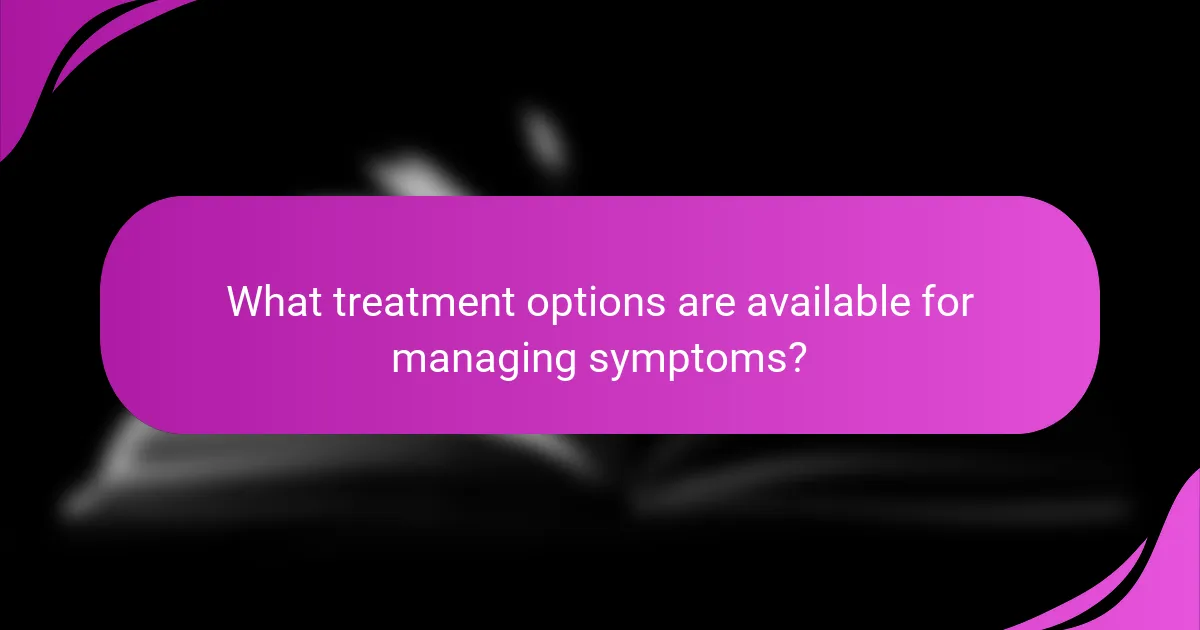
What treatment options are available for managing symptoms?
Medications, therapy, lifestyle changes, and support groups are effective treatment options for managing bipolar disorder symptoms. Medications include mood stabilizers and antipsychotics, which help regulate mood swings. Therapy options, such as cognitive behavioral therapy (CBT) and interpersonal therapy, provide coping strategies and emotional support. Lifestyle changes like regular exercise and a healthy diet can improve overall well-being. Support groups offer community and shared experiences, helping individuals feel less isolated. Each treatment option can be tailored to individual needs for optimal symptom management.
What role do medications play in symptom management?
Medications play a crucial role in managing symptoms of bipolar disorder by stabilizing mood and reducing the frequency of mood swings. Commonly prescribed medications include mood stabilizers, antipsychotics, and antidepressants. Mood stabilizers, such as lithium, help maintain a balanced mood and prevent manic or depressive episodes. Antipsychotics can address severe symptoms, while antidepressants may be used cautiously to avoid triggering mania. Regular monitoring and adjustments by healthcare professionals ensure effective treatment tailored to individual needs.
What types of medications are commonly prescribed?
Medications commonly prescribed for bipolar disorder include mood stabilizers, antipsychotics, and antidepressants. Mood stabilizers like lithium help regulate mood swings. Antipsychotics, such as quetiapine, address severe symptoms. Antidepressants may be used cautiously to prevent manic episodes. Each medication has unique attributes, such as dosage and side effects, that require careful consideration.
How do side effects impact treatment adherence?
Side effects can significantly reduce treatment adherence in individuals with bipolar disorder. Patients may experience mood swings, energy changes, and other symptoms that can be exacerbated by medication side effects, leading to non-compliance. Research indicates that up to 50% of patients discontinue their treatment due to adverse effects. Common side effects include weight gain, fatigue, and cognitive impairment, which can further complicate the management of bipolar disorder. Addressing these side effects through open communication and tailored treatment plans is essential for improving adherence and overall outcomes.
What therapeutic approaches are effective for bipolar disorder?
Cognitive Behavioral Therapy (CBT), Dialectical Behavior Therapy (DBT), and medication management are effective therapeutic approaches for bipolar disorder. CBT helps individuals manage symptoms by changing negative thought patterns. DBT focuses on emotional regulation and interpersonal effectiveness. Medication, including mood stabilizers and antipsychotics, addresses chemical imbalances. Combining these approaches often yields the best outcomes, improving mood stability and overall functioning.
How can cognitive-behavioral therapy help?
Cognitive-behavioral therapy (CBT) effectively helps individuals with bipolar disorder manage mood swings and energy changes. It teaches coping strategies, enhances emotional regulation, and addresses negative thought patterns. Research shows CBT can reduce the frequency and severity of episodes, improving overall functioning.
What is the importance of psychoeducation?
Psychoeducation is crucial for understanding bipolar disorder, as it empowers individuals to recognize symptoms and manage mood swings effectively. It enhances awareness of energy changes, enabling better coping strategies. Moreover, psychoeducation fosters communication between patients and healthcare providers, improving treatment adherence and outcomes. Engaging in psychoeducational programs can significantly reduce relapse rates and improve overall quality of life for those affected by bipolar disorder.
What lifestyle changes can support symptom management?
Lifestyle changes can significantly support symptom management in bipolar disorder. Regular exercise enhances mood stability and reduces anxiety. A consistent sleep schedule helps regulate energy levels and mood swings. Healthy nutrition, including omega-3 fatty acids, can improve overall mental health. Mindfulness practices, such as meditation, aid in emotional regulation. Additionally, social support networks provide essential connection and understanding.
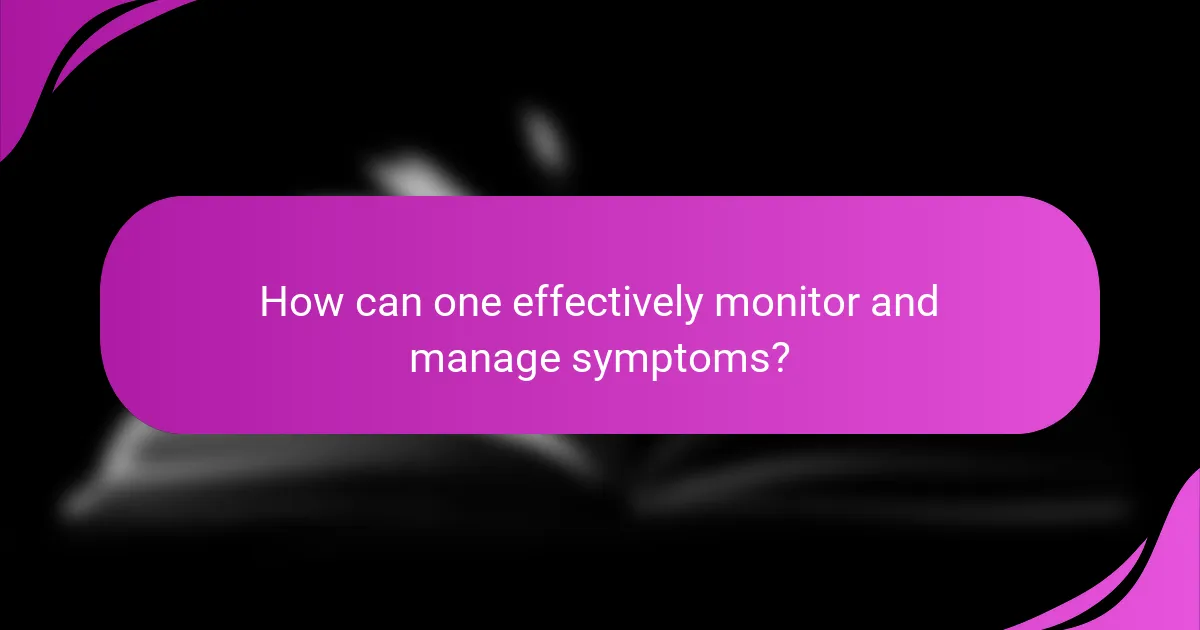
How can one effectively monitor and manage symptoms?
To effectively monitor and manage symptoms of bipolar disorder, maintain a daily mood journal. Track mood swings, energy levels, and triggers to identify patterns. Regular communication with healthcare providers is essential for adjusting treatment plans. Implementing coping strategies, such as mindfulness and exercise, can also help stabilize mood.
What strategies are recommended for tracking mood changes?
To track mood changes effectively, maintain a daily mood journal. This practice helps identify patterns and triggers. Use apps designed for mood tracking to log emotions, energy levels, and sleep quality. Regularly review entries to recognize fluctuations and discuss findings with a mental health professional. Engaging in mindfulness techniques can also enhance awareness of mood shifts.
What common mistakes should be avoided in symptom management?
Avoiding common mistakes in symptom management for bipolar disorder is crucial for effective treatment. Key errors include neglecting to monitor mood changes, failing to adhere to prescribed medication, and not communicating openly with healthcare providers. Additionally, underestimating the importance of a support system can hinder progress. Recognizing these pitfalls is essential for improving overall management and stability.
What expert insights can enhance treatment outcomes?
Expert insights can significantly improve treatment outcomes for bipolar disorder by focusing on personalized care strategies. Tailoring treatment plans based on individual symptoms, such as specific mood swings and energy fluctuations, enhances effectiveness. Regular monitoring of symptoms allows for timely adjustments in medication and therapy. Incorporating psychoeducation empowers patients and families, fostering better understanding and management of the disorder. Collaborative treatment approaches that include mental health professionals, patients, and support networks lead to more comprehensive care. Additionally, integrating lifestyle changes, such as exercise and nutrition, can support overall well-being and stabilize mood.
